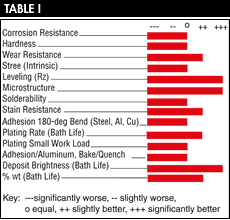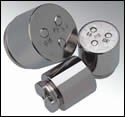Putting The Brakes On Lead and Cadmium
Ambrake Manufacturing had to remove lead and cadmium from its electroless nickel solution in order to comply with the End of Life Vehicle Directive. The company turned to its electroless nickel suppliers for support...
Ed Embry, senior plating engineer at Ambrake Manufacturing, Elizabethtown, KY, knew that his company’s mid-phosphorus electroless nickel baths did not contain much lead or cadmium. However, after learning about the European Union’s End of Life Vehicle Directive (ELVD), which eliminated lead and cadmium from deposits on automotive parts, he wanted to know how much of these elements were in the deposit on Ambrake’s brake pistons. He started by asking his suppliers, who replied that they doubted there was much, considering there is only 1-3 parts per million (ppm) of each metal in the working solution.
Embry was surprised to learn that there is as much as 500 ppm of cadmium and lead in the deposit; well over the acceptable level as determined by the ELVD. (See Find Out More Box). Ambrake had to find an alternate electroless nickel (EN) chemistry for the pistons used in the disc brakes it manufactures for the automotive industry, including customers such as GM, Pontiac, Saturn, Nissan, Honda, Toyota among others.
Ambrake manufactures other brake parts that are zinc plated and/or electrocoated. The company had already removed the chromium from its electrocoat paint bath and was in the process of converting its hexavalent chromium conversion coatings after acid zinc plating to trivalent chromium coatings. To date, only clear trivalent coatings have been installed. The company knew that if it wanted to maintain its position as a major OEM supplier to the automotive industry, it also had to make the conversion to a lead- and cadmium-free electroless nickel process.
Based on the history of EN, this could have been a difficult process. Lead has been used for years in electroless nickel solutions to stabilize the plating process, prevent spontaneous decomposition and simplify operation. Cadmium imparts a high level of brightness and leveling to the deposit. Over the years, these two additives have played an important role in the commercial success of the EN process. Finding suitable, environmentally friendly replacements would be a challenge. Ambrake turned to Sirius Technology, Inc., Oriskany, NY, to help it find a lead- and cadmium-free electroless nickel that would still meet all the stringent performance characteristics needed for their brake pistons.
Sirius Technology recognized that the mandate issued by the European Union would create an opportunity to introduce a new product line of electroless technology without lead or cadmium. Product development was initiated in early 2002 and as a result, a commercially viable process was introduced for field testing approximately six months later. In November 2002, Ambrake began testing a bright lead- and cadmium-free electroless nickel process. Since none of its customers had yet requested lead- and cadmium-free electroless nickel, Ambrake anticipated that it would have 1-2 years to develop the process and be ready for startup when the ELVD went into effect. The new electroless nickel process would have to plate all the steel pistons manufactured at Ambrake and meet all of its customers’ requirements. The deposit also had to meet all of Ambrake’s requirements for corrosion resistance, hardness, wear resistance, leveling (Rz) and stress. Also, the bath had to be a drop-in replacement that matched the plating rate and processing sequence of its previous process. “We isolate all the parts. A part does not go out as an approved part unless it meets strict parameters,” comments Embry.
Developing and implementing the new electroless nickel bath was no small feat. “We do not make any changes quickly around here,” says Embry. “Because we deal with automotive, we have to make sure that the replacement meets all the requirements for each customer and will work within our QS, ISO and other certifications.” Each automotive company has its own set of finishing standards and performance characteristics. This required highly coordinated testing and certification procedures. Because Ambrake Manufacturing and Sirius Technology started the approval process early enough, Ambrake was ready when one of its customers called in February 2003 requiring that its parts be ELVD compliant by May 2003.
The first part of the PPA
(Pre-Production Approval Process) required the testing of the deposit produced from the lead- and cadmium-free chemistry. Plated pistons were tested at each metal turnover (MTO) throughout the entire bath life of 10 metal turnovers. The performance characteristics were evaluated based on the following parameters: alloy composition, corrosion resistance, hardness (after heat treatment), wear resistance, porosity, leveling, intrinsic stress, microstructure, adhesion, brightness, plating rate, solution stability and percent phosphorus vs. bath life.
Inductively coupled plasma (ICP) analysis was used to compare the deposit assay for the mid-phosphorus lead- and cadmium-free coatings to the deposit characteristics obtained from standard electroless nickel chemistries. The performance evaluations comparing the two coatings are shown in Table I. The mechanical and chemical performance characteristics of the lead- and cadmium-free EN deposit were the same or better than the standard electroless nickel deposit.
Because the electroless nickel line at Ambrake is compact, enclosed and efficient, there is no room for extra tanks, thus the new process needed to be a drop-in replacement. The line features six 280-gal electroless nickel plating tanks, typically using five at one time. When implementing the new process, Ambrake began with staging the tanks rather than starting up five new baths. This way, Ambrake would not have to dispose of all five tanks simultaneously after 10 turnovers, stalling production.
The line also features a specialized system for loading pistons onto the line. Parts are placed in baskets that are stacked six high in trays. The trays are then loaded into the system for cleaning and plating. For testing purposes, parts were pulled from various positions within the trays during the plating process, after plating and after heat-treating. These parts were tested to determine leveling, adhesion, thickness, hardness, corrosion resistance and porosity.
Tanks and fixtures are color coordinated, with each tank having an identifying color. This way, if a part or batch of parts has defects, the problem can be traced easily back to the corresponding electroless nickel bath, where potential problems can be quickly identified and corrected.
Following 63 minutes of EN plating, parts go through a series of rinses and are then heat treated at 370°C for 120 min. The rinses following EN plating are important for removing all of the bath constituents. If these are not removed, parts will likely emerge from heat treating with a blue or black color. After heat-treating, parts are polished, transported to final assembly, packaged and shipped. Fixtures and baskets return to the EN line for cleaning.
Developing and implementing new processes, whether to comply with new directives such as the ELVD, improve production or improve deposit characteristics, always requires cooperation between the finisher, its customers and the supplier. The new electroless nickel system at Ambrake Manufacturing is an example of this cooperative effort.
Both Ambrake Manufacturing and Sirius Technology are committed to continuous improvement at all levels. The lead-free/ cadmium-free electroless nickel process development was accelerated by the ELVD implementation and customers’ concerns about compliance. The key strategic alliance between Ambrake Manufacturing and Sirius Technology has resulted in a product that provides the automotive industry with a competitive advantage.
Related Content
Ultrafiltration Membranes, Filter Elements for Improved Industrial Water Reuse
Ultrafiltration membranes help with water reuse in a variety of applications.
Read MoreNASF/AESF Foundation Research Project #120: Electrochemical Destruction of Perfluorooctanesulfonate in Electroplating Wastewaters – January – December 2023
This NASF-AESF Foundation research project report covers quarterly reporting for the year 2023 at the University of Illinois at Chicago. The objective of this work is to utilize a cost-effective reactive electrochemical membrane (REM) for the removal of PFAS from synthetic electroplating wastewater. Discussed here are the oxidation of PFOA with three different catalysts, development of a method for detecting PFAS, as well as work on 6:2-fluorotelomersulfonic acid (6:2 FTS) and electrodeposited bismuth/tin oxide catalysts.
Read MoreNASF/AESF Foundation Research Project #122: Electrochemical Approaches to Treatment of PFAS in Plating Wastewater - 7th Quarterly Report
The NASF-AESF Foundation Research Board has selected a project on addressing the problem of PFAS and related chemicals in plating wastewater streams, studying PFAS destruction via electrooxidation and electrocoagulation. Our last report described the results from experiments of EO with a Magnéli phase Ti4O7 anode on the degradation of eight perfluoroalkyl acids (PFAAs). In this seven quarter report, we describe work to further explore how the degradation of different PFAAs are related to their molecular structures.
Read MoreNASF/AESF Foundation Research Project #122: Electrochemical Approaches to Treatment of PFAS in Plating Wastewater - 12th Quarterly Report
This NASF-AESF Foundation research project report covers the 12th quarter of project work (October – December 2023) at the University of Georgia. In our previous report, we described our work on performance and effect of surface fluorinated Ti4O7 anodes on PFAS degradation in reactive electrochemical membrane (REM) mode. This quarter, our experiments involved utilizing porous Ti4O7 plates serving both as anodes and membranes. Tests compared pristine and F-18.6 Ti4O7 anodes at current densities of 10 mA/cm2 and 40 mA/cm2. This 12th quarterly report discusses the mechanisms of the effects on EO performance by anode surface fluorination.
Read MoreRead Next
Education Bringing Cleaning to Machining
Debuting new speakers and cleaning technology content during this half-day workshop co-located with IMTS 2024.
Read MoreEpisode 45: An Interview with Chandler Mancuso, MacDermid Envio Solutions
Chandler Mancuso, technical director with MacDermid Envio discusses updating your wastewater treatment system and implementing materials recycling solutions to increase efficiencies, control costs and reduce environmental impact.
Read MoreDelivering Increased Benefits to Greenhouse Films
Baystar's Borstar technology is helping customers deliver better, more reliable production methods to greenhouse agriculture.
Read More
























